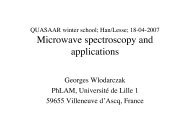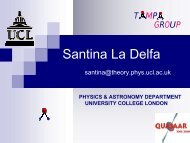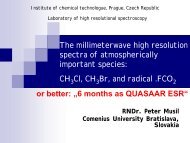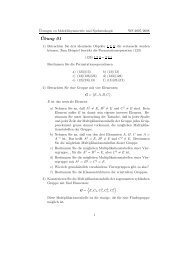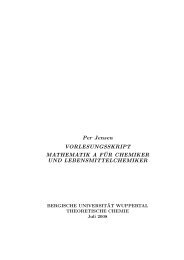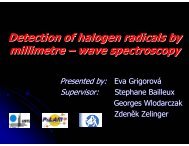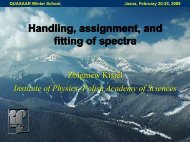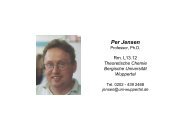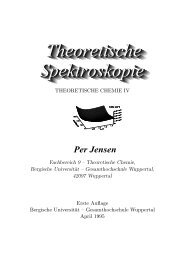Abstract book - Prof. Per Jensen, Ph.D. - Bergische Universität ...
Abstract book - Prof. Per Jensen, Ph.D. - Bergische Universität ...
Abstract book - Prof. Per Jensen, Ph.D. - Bergische Universität ...
- No tags were found...
You also want an ePaper? Increase the reach of your titles
YUMPU automatically turns print PDFs into web optimized ePapers that Google loves.
172 Poster session, J9On the ECS formalism applied to 60-GHz oxygen absorption bandprofile.Dmitriy Makarov 1 , Christian Boulet 21Institute of Applied <strong>Ph</strong>ysics, Russia, dmak@appl.sci-nnov.ru;2Institut des Sciences Moleculaires d'Orsay, France, christian.boulet@u-psud.frMakarov D.Boulet C.Absorption profile of the 60-GHz molecular oxygen band, which is widely used foratmosphere remote sensing, wireless communications and other applications, isformed by overlapping profiles of fine structure transitions. It is shown that collisionalcoupling has noticeable effect upon the band absorption profile 1 and should be takeninto account in radiation propagation models.Absorption profile influenced by collisional effects is usually described by expressionincluding collisional relaxation matrix W 2,3 . As far as mentioned expression includesmatrix inversion, it is possible to calculate model profile of the band at least in twoways: the first way is using direct numerical inversion, the second one is usinganalytical expression based on the approximation methods 3 .In current study, the ECS formalism 4 is used to calculate relaxation matrix elements inthe same way that in 5 . Within ECS approach, W matrix elements are calculatedthrough the expression having three parameters. Advantage of the ECS formalism inapplication to collisional coupling of lines in 60-GHz band is absence of constraintson the relaxation matrix structure and features of coupling between individualbranches forming the band. Absorption profile is calculated using numericalinversion. Earlier obtained experimental data on the molecular oxygen 60-GHz bandabsorption profile at temperatures from -30 to +60 o C at atmosphere pressure 6 wereprocessed with the ECS model profile. For each temperature ECS relaxation matrixparameters values were determined by fitting model profile to the experimental one,temperature dependencies of the parameters were plotted. Using ECS formalism for60-GHz band absorption profile modelling allows further increase of the modellingaccuracy in comparison to previously developed second-order MPM extension6 in thewhole temperature range from -30 to +60 o C where the measurements were carriedout, and gives more thorough performance of coupling between the fine-structurelines of molecular oxygen 7 .The work is partially supported by RFBR grants 12-02-00059-а, 12-05-00309-а.References[1] P.W. Rosenkranz, IEEE Transactions on Antennas and Propagation 23(4), 498-506, 1975[2] R.G. Gordon, J. Chem. <strong>Ph</strong>ys. 46(2), 448-455, 1967[3] E.W. Smith, J. Chem. <strong>Ph</strong>ys. 74(12), 6658-6673, 1981[4] A.E. DePristo, S.D. Augustin, R. Ramaswamy, H. Rabitz, J. Chem. <strong>Ph</strong>ys. 71, 850-865, 1979[5] H. Tran, C. Boulet, J.-M. Hartmann, J. Geophys. Research. 11, D15210, 2006[6] D.S. Makarov, M.Yu. Tretyakov, P.W. Rosenkranz, J. Quant. Spect. Rad. Transfer112(9), 1420-1428, 2011[7] C.Boulet, D.S. Makarov, in preparation




